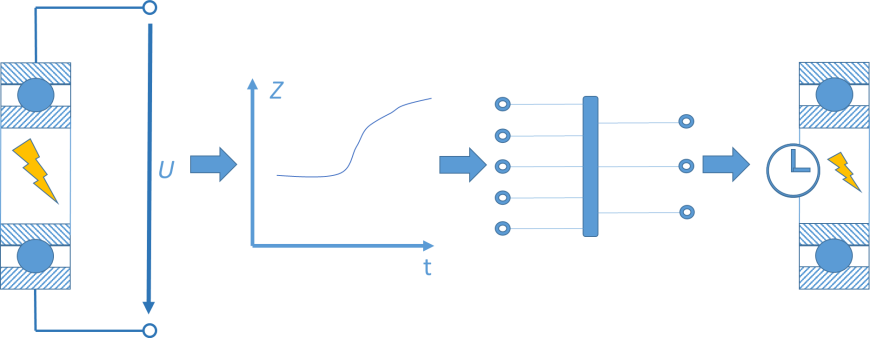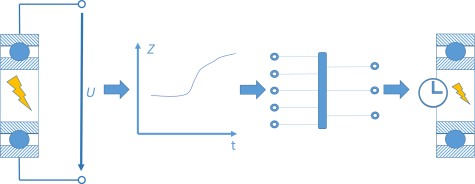WälLagSchaden
Early damage detection on rolling bearings by electrical impedance measurement
Initial Situation
Rolling bearings are one of the most important machine elements, because they are used in many machines and have a brought application spectrum. Unforeseen bearing damages are the main reason for early machine failures. So condition monitoring of rolling bearings becomes more important to reduce maintenance costs. Now it is state of technology to use solid-borne sound data and vibration data of sensors located at the machine housing among other things for monitoring the bearings. Main problem is, that this signals may be overlain by disturbances, e.g. from the gear mesh. Early research at the institute pmd shows that measuring the rolling bearing impedance can detect bearing damages, locate and dimension them inside the bearing, identify the bearing load and display the rotary shaft speed [1]. This project focuses on the early detection of rolling bearings by impedance measurement, which uses the plate capacitor as electrical analogous model of the rolling contact [2].
Project Goals
The aim of this DFG project is to identify significant changes in the impedance signal and its features over the operating life of different rolling bearings as indicators for bearing failures. These indicators shall be used for diagnosing the bearing condition with the help of machine learning methods. The reasons for their change over the bearing lifetime will be investigated, too.
Procedure
At the beginning, rolling bearings of the same type and the same scale will be run in fatigue tests at the Athene test rig under constant revolution speed and different loads until bearing failure. In the meantime, the impedance signal of the bearings is measured and different indicators in time domain and frequency domain will be built. Using common selection methods from machine learning, the best features for diagnosing bearing damages and classifying the operating life phases will be extracted. Simultaneously the phenomenal explanation of the bearing impedance changes over the lifespan will be investigated under consideration of raceway surface changes. In the next step, the fatigue test results and the selected features are transferred to different rolling bearing types to check the generality. In the end the bearing scale influence is researched. The results will be integrated into the damage early detection method as well.
[1] Martin G., Becker F., Kirchner E. (2022): A novel method for diagnosing rolling bearing surface damage by electric impedance analysis, Tribology International, https://doi.org/10.1016/j.triboint.2022.107503
[2] Schirra T. (2021): Phänomenologische Betrachtung der sensorisch nutzbaren Effekte am Wälzlager – Einfluss unbelasteter Wälzkörper auf das elektrische Impedanzmodell [Dissertation]: TU Darmstadt; 2021







